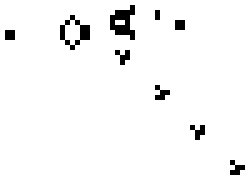将 Conway’s Game of Life
这款游戏,使用OpenMPI库重新并行化实现。
Goal
In this project, you will be parallelizing Conway’s Game of Life in C using
the OpenMPI library.
Getting started
We have provided you with many files to the program, which we will describe
below:
- A serial (sequential) version of the program called src/life_seq.c. You should take a look at how this program implements the game. Also, the serial version will be used to generate the canonical output for the program. You should feed the input files into this program in order to see what the correct output is.
- The starter code for the program called src/life_mpi.c This is the only file you will be modifying in this project.
- A sample MPI program that shows how message passing works called src/sample_mpi.c
- run/install_mpi.sh which will install MPI on your virtual machine. Make sure you are using a Mac or the course VM from project 5. DO NOT use Windows. If you are using a Mac with homebrew, you can run brew install open-mpi
- In order to compile all of the examples and the src/life_mpi.c programs, you should go to the run/ directory. You can either use the Makefile or the run_*.sh scripts to build and run your programs.
- Visualization and random input generation scripts. These are called tools/life_visualizer.py and tools/input_generator.py respectively. There is an attached tools/TOOLS_README.txt document with these two files which explains how they function.
- For more information, please see the README file under the project directory.
How the game works
The Game of Life consists of an N by M matrix, where each cell can either be 0
(dead) or 1 (alive). The game will start with the cells corresponding to the
(x, y) coordinates in the initial input file being set to 1 (alive). This is
the “first generation” of the game. The game consists of constructing
successive generations of the board based on certain rules which are described
below:
- Cells with 0,1,4,5,6,7, or 8 neighbors die (0,1 of loneliness and 4-8 of overpopulation)
- Cells with 2 or 3 neighbors survive to the next generation
- An unoccupied cell with 3 neighbors becomes occupied in the next generation.
This is how the game will function. For more information on the Game of Life,
check out the link at the beginning of the file.
Implementing the game using MPI
We have provided some starter code, which includes all of the initialization
of the MPI functionality for the program, as well as the code for the rank 0
process. You will need to implement the code for the rank 1 to n processes
(worker processes). The images below briefly illustrate how the MPI-
parallelized game works.
Note
If you wish to implement the entire MPI-parallelized game of life instead of
using the provided code, please feel free to do it in life_mpi.c.
Running the serial and MPI programs
First, go to the run/ directory. Then, you can use either the Makefile or the
run_*.sh files to run the programs.
Testing with the sample input/output
You can use the 4 sets of sample input/output files located in the run/
directory to test your program.
Testing with the input generator tool
First, you can create random inputs for the program using the
input_generator.py script. Next, you should run these input files either
through the visualizer or the serial version in order to get the correct
output for the final generation that you specified. Finally, run the MPI
program with the input file and get the output from that.
Comparing the output files
We recommend using the diff command (or https://www.diffchecker.com/
if you prefer a graphical display) to verify
that the output from your MPI program is the same as the output from the
serial version.
Submission
Submit the life_mpi.c file to the submit server. It will be graded offline.
And, since you can easily test your program locally, all tests on our side
will be secret.


